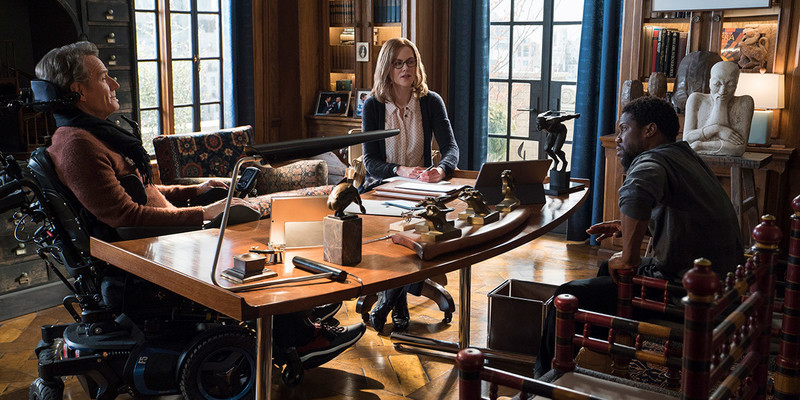It was probably inevitable that the tremendously successful French film “The Intouchables,” about a wealthy quadriplegic and his black caretaker recently released from prison, would find its way to Hollywood. The contrived premise of the film, which makes few changes in the American remake, “The Upside”—starring Bryan Cranston as the wealthy Philip and Kevin Hart as his street-smart assistant Dell—is an appealing one for Hollywood. This is an odd couple bromance predicated on stereotypes that, while they certainly reflect lived-in experiences—Dell has all but given up finding a job as an ex-con, and all the money in the world can’t help Philip get over losing his wife to cancer—they still remain uncomfortable stereotypes, nonetheless.
Cranston and Hart are pros, though, and do much with the extremely limited, telegraphed material. Even though Dell inadvertently stumbles into the job interview and proceeds to totally unimpress Philip’s executive (Nicole Kidman)—calling her Philip’s “boo”—the old man believes Dell is the only person suitable for the job. Perhaps Philip has a death wish, or sees the potential in Dell, a man who doesn’t have his life together (he’s been kicked out of the apartment by his wife after routinely failing to provide for her and their son).
Unlike most crotchety old men, Philip appreciates that the younger, unrestrained Dell isn’t afraid to speak his mind. Dell finds much to dismantle comedically in Philip’s rich and stuffy life: Opera, fine art, an absurdly complicated shower system that speaks to Dell in German. The arcs the two men go through thanks to their friendship are cliched to a point—Dell finally learning how to take care of someone allows him to take care of his family, too—but “The Upside” has a tenderness that allows it to sell the smaller moments that indicate the characters’ growth. The bigger moments are comedic, and are occasionally, genuinely charming—like Dell replacing Philip’s urine catheter for the first time, unable to say “penis” aloud. You can thank Hart and Cranston for enlivening the material.
But, of course, the film can never escape the magic-black-man stereotype in which a privileged white person finds life worth living again thanks to their larger-than-life black servant, and that’s because of the narrative premise’s DNA. This is why a movie like “The Upside” never fully works: No matter how heartening the performances are, how hard Hart and Cranston work to make us forget about the transparent blueprint design of the narrative, ultimately, the film makes one feel queasy.

You’ve probably heard of the Milgram experiment: a controversial social psychology experiment that revealed that the majority of people will eventually resort to inflicting violence on peers—even if they are initially unwilling—if someone of high-enough authority demands them to. Conducted by Stanford university researcher Stanley Milgram, the experiment helped to answer the question of how so many people in Germany carried out a bloodthirsty tyrant’s orders. As the science of psychology has proven, humans are disturbingly subservient—we are socially conditioned to hurt, even kill others, if put in the right circumstances.
That’s the dark, uncomfortable reality explored in “The Captain,” an exquisitely shot black-and-white WWII historical drama set in the final weeks before Germany’s fall. “The Captain” captures the desperation and scarcity of resources in its opening scenes as a starved, lost German soldier, Herold (Max Hubacher) barely escapes trigger-happy German soldiers and farmers trying to protect their food sources. But when he comes across a captain’s uniform in a deserted car, Herold sees a path out of his desperation. He poses as a captain under the direct orders of the Fuhrer himself and manages to con every soldier and higher-ranking official of the Nazi party that he meets.
Herold’s transformation from scared, blood-spattered waif to a cold, assured, and cruel Nazi is incisively depicted and not without some delightfully dark German humor. One memorable tongue-in-cheek shot involves Herold looking back at the side-view mirror of the car—like other objects, he appears larger than he really is.
Part of the film’s success lies in its adept and measured use of running time to show how almost every single person Herold encounters can bend under social pressure and the multiple unnerving, and serious tests that Herold must go through in order to prove his rank—the checkpoints are quite literal in the film as the “captain” finds a way to bluff through any and all requests for papers.
After organizing a band of lost soldiers, Herold finds himself challenged time and time again at a camp holding German soldiers who are being detained for deserting and looting. He arranges for their executions—a massacre contextualized by the time-wasting bureaucracy of Nazis who are all trying to follow orders and play by certain protocol, yet are under the sway of disappointing Hitler. We also come to feel the brunt of the pain and suffering of the people who are killed and the remaining members, and who might be next. The film also richly portrays how war-worn people resorting to partying and other debaucheries can lead to more violent forms of catharsis.
“The Captain” pushes the unbelievable power and myth of Herold’s real status right through to his conviction, when a judge tries to make the absurd argument that Herold’s success is actually admirable and exactly what the Nazi party needed to succeed. This is a film that fully understands the psychology of the German soldiers and offers unflinching, timeless truth.
